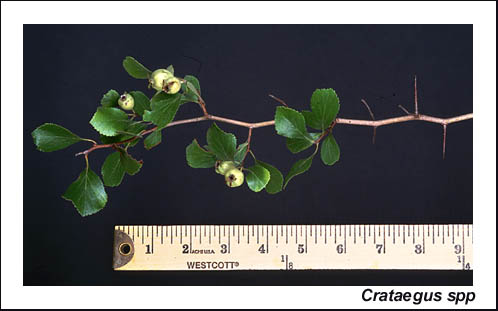Hawthorn
Crataegus spp.
Family: Rosaceae
Natural History

Hawthorns represent a very large genus in the Rose family, with over 1,000 species. Many of these species are difficult to identify, so they are often referred to as simply hawthorns, or haws, from the old English word for hedge. Other common names include white thorn, summer haw, and yellow haw. The members of the genera hybridize easily, resulting in much variation in features.
The fruits of hawthorn trees, often called haws or thorn-apples, may persist until late fall or early winter when they serve as an important source of food for numerous wildlife species, especially wild turkey and ruffed grouse. Raccoons, squirrels, rabbit, small rodents, and deer also consume the fruits and seeds. While it is not considered to be a high quality browse, white-tailed deer will occasionally eat the twigs and leaves as well. The seeds are eaten by many species of songbirds, including cedar waxwings, northern flickers, mockingbirds, cardinals, and bluejays, who are instrumental in the dispersal of seeds and regeneration of more hawthorns. Hawthorn thickets provide excellent refuge for small mammals and birds. The American woodcock is a common inhabitant of hawthorn patches.
The flowers of hawthorn often has a pungent odor, similar to the smell of decomposing flesh. This scent attracts insects, especially carrion beetles, who then pollinate the flowers.
The wood of hawthorn is of little commercial value. However, the lustrous green foliage, attractive flowers, and brightly-colored fruits make hawthorn a desirable ornamental tree. Hawthorn is susceptible to damage from insects and disease and can be aggressive invaders of fields and pastures.
Hawthorns may be found in coastal plains and Piedmont regions from Virginia south into Florida and west to Missouri, Tennessee, and Texas. Some species also grow in the Mississippi River valley.
